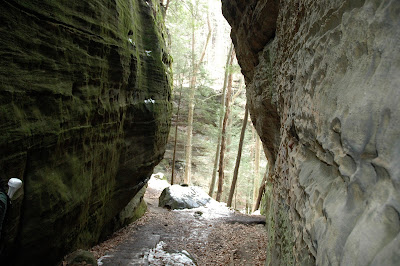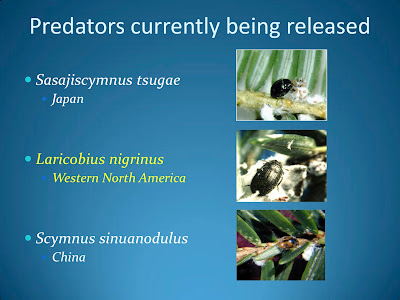Back in November, several area workshops were given on the threat to our Eastern Hemlocks, Tsuga canadensis, from the latest invasive species, the Hemlock Wooly Adelgid, Adelges tsugae. Most people are unaware that this species is found along the west coast of North America, and is considered native in that area. Those populations remain in balance, and are not usually fatal to the trees. They are non-native here, as there is no historic record of them ever being in the eastern U.S.
Cantwell Cliffs State Park is where the outbreak was discovered. For those who have never been there, a very narrow and slippery set of stone stairs lead down to the main area of the park.
As the rocks widen, a hemlock filled gorge soon becomes apparent.
As with other beautiful scenic areas of the Hocking Hills, Cantwell Cliffs is named that for a reason. The cliffs are high and dangerous. You should always stay on the trails when visiting these areas. It's much too far from Old Man's Cave to suffer an accident.
With the help of my Forest Entomology students, we begin the search. This is Pat Quackenbush, naturalist for the Hocking Hills region. Notice how we start by looking on the bottom of the branches. On a mild outbreak such as this one, they will only be visible under the needles. A heavy infestation will have them on both sides.
Stephanie Downs, of the Ohio Division of Forestry, braves climbing on rock outcrops to check hemlocks.
Should you decide to except this mission, the public must not know the exact location of the enemy. Your mission may involve the thrill of victory, or the agony of defeat. Here Pat climbs along the cliff face on snow and ice in search of adelgids. Because of the seriousness of this insect, we often have to check locations we normally wouldn't venture to.
I have known about this outbreak for some time now, but was sworn to secrecy until the government agencies could release an official statement. By the way, this tape will self destruct in 5 seconds.
Rather than wander aimlessly throughout the park, Dave Apsely of the Ohio State Extension Service checks the exact known GPS locations in the park. There are several spots in the park they have been found. I won't disclose those specific locations. We don't want the public to carry them on their clothes by accident to other hemlock dominated parks in the area.
Here was our first success. One insect on each left branch, three on the right. Can you imagine checking countless hemlocks for something so small?
As we moved around, we found trees with many more insects on them. These branches were easier to spot. Below is more information from a variety of powerpoints on the biology, spread, and control of this insect.
The Hemlock Wooly Adelgid belongs to the order Hemiptera. In particular the sub-order Homoptera, which consists of Cicadas, Aphids, Scale, Leafhoppers and Treehoppers. Adelgids are very small insects, often mistaken for Wooly Aphids. Below is some information on the difference between the two groups.
The White Pine Adelgid, Pineus strobi, is a different insect entirely. It concentrates its attack to the trunks of several pine species, most often White Pine, Pinus strobus. It is rarely fatal to the tree. The Hemlock Adelgid positions itself at the base of each leaf petiole.
Another similar and confusing species is this Scale insect. Notice the dirty cobweb like appearance to the needles.
Wet bubbles are larger than Adelgids, and much fewer in numbers. Certain spiders lay white egg sacs on plants, but they too will be few and more scattered.
Upon hatching, these Adelgids look like black pepper grains sprinkled among the branches. As they grow these "crawlers" will turn more gray. This one has already increased in size. Upon settling down to feed, (where they will no longer move), they begin to emit the white waxy or wooly coating that we recognize them by. They do not chew the tree, but have piercing/sucking mouthparts. The date on the slide refers to the infestation at Smoky Mountain National Park.
Here are some of the Hocking adelgids coated in white. You can see one of the gray critters not yet covered. Surveying hemlocks when covered in snow is not a good idea. It's too difficult. They are laying eggs for the next generation right now. About the time the Redbud trees come into bloom in our area, the nymphs or "crawlers" will begin to move around the trees. This is a crucial time to make sure you don't let them attach to you or your clothing.
Speaking of the Smokies, here is a picture of the damage inflicted by this little guy. This species of Adelgid is definitely fatal to both Eastern and Carolina Hemlocks, Tsuga caroliniana.
Here is a bit of history on the spread of this insect. It came over on a Japanese species of hemlock being used for landscaping. Though these insects are the same species as in Western N.A., the genetics do show differences in the Asian populations. Because of this, the invasion is being called an exotic pest.
The green indicates the range of Eastern Hemlock.
To my knowledge, these are the only known locations of the insect in Ohio. Keep your fingers crossed, but it is likely this map will be changing. It has spread rapidly through Kentucky and West Virginia. We haven't been able to stop it, so all we can do is try to slow it down.
During the workshop, estimations of their arrival varied from 1-5 years. Knowing they can hitch a ride on birds feet, I personally felt they would be here this year.....and now we know.
Spraying foliage has been one method of direct control.
Soil or basal injections are another option. As the chemical travels up the tree, it kills the insect upon ingestion. There are several kinds of these kits, ranging from $300 to $3,000. Besides the cost, the real problem is that you have to inoculate each tree one at a time. This will be impractical on a forest wide basis. Management decisions will have to be based on which trees are deemed most important, and which areas are subject to recreational use. A heavily visited area by people introduces the possibility of more hitch hiking.
Biological control, together with chemical control, are both being used to battle this insect. It's funny how some eyes roll when you mention the introduction of bio control. Just because of the Asian Ladybird Beetle. Far many more biological controls have been successful in both controlling, and eliminating certain pests. People just don't remember those. Out of sight, out of mind I guess.
Special attention is being paid to the middle one, L nigrinus. This little black beetle, only a couple millimeters long, is the native control species found out west. Even if they only eliminate half the Adelgid population, that's enough for the trees to survive. Depending on how many beetles are released, some studies show over 90% of the Adelgids are eradicated.
The Hemlock Adelgid produces two broods a year. It remains mostly dormant during the hot summer months. Winter time is when it feeds. Extremely cold winters have knocked back populations in the New England states, but studies also show that warming temperatures and mild winters contribute to its spread. The great thing about this beetle is it too comes out in winter to attack Adelgids. In the previous photo, Scymnus coniferarum is another western native beetle that feeds in summer. Thus we can attack the pest year round.
For people or landowners concerned about what they can do on their own property, look to the internet for information that is constantly being updated.
For permission to use many of these illustrations and photographs, thanks go to
Stephanie Downs-Ohio Division of Forestry
Dave Apsley-Ohio State University Extension Service
Jesse Webster-Smoky Mountain National Park
And for the construction and presentation of the aforementioned powerpoints:
Dr. Curtis Young-Ohio State University
Dave Adkins-Ohio Department of Agriculture
Brad Onken & Bill Oldland-U.S. Forest Service, Morgantown WV
Dr. Richard McDonald-saving hemlocks (a nice YouTube video)












.jpg)


















I heard about the Cantwell Cliffs incursion at the Marietta presentation a few weeks ago...it really hit me hard, I love that place. I'll be checking around Washington County, it's been found in Marietta and Belpre already, so I'm sure it will reach Athens County soon, sadly. Keep us posted on any beetle releases.
ReplyDeleteI was diagnosed with Parkinson’s four years ago, and after my symptoms continued to worsen despite medication, I tried a herbal program from NaturePath Herbal Clinic. Over time, I personally noticed improvements in my tremors, balance, and overall energy. Everyone’s experience is different, but if you’re exploring alternative approaches, you can learn more on their site: www.naturepathherbalclinic.com
ReplyDeleteor contact info@naturepathherbalclinic.com